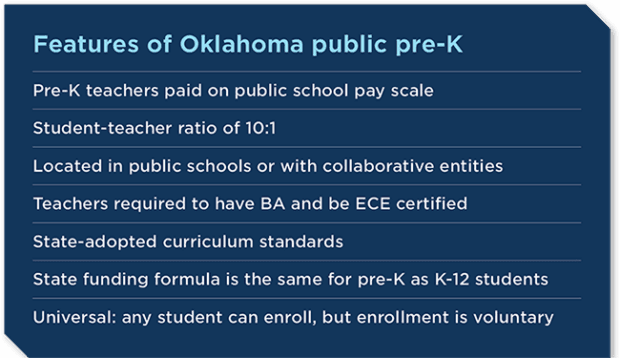New Study Can Guide Policies To Maximize Pre-K’s Benefits to Students
Author
Our recently published study of the Tulsa, Oklahoma pre-K program, a state-funded universal program, followed students from pre-K through middle and high school, finding that middle school students who had attended pre-K demonstrated higher standardized test scores and lower rates of grade retention than similar students who hadn’t attended pre-K. For students followed through high school, we found that pre-K is associated with lower rates of grade retention and fewer days absent in high school. Students who attended the program were also significantly less likely to fail a course and more likely to take an Advanced Placement or International Baccalaureate course, relative to similar students who did not attend the program. Although the effects of pre-K were larger for elementary students than for the same students in high school, they are large enough—and with sufficient outcomes—to highlight the importance of pre-K to students’ long-term success.

We also found that pre-K may have more sustained impacts on a range of outcomes for students who identify as Black, Hispanic, or Native American. Native American students demonstrated gains in SAT scores from attending pre-K, a finding not replicated with other students, and Hispanic students who attended pre-K demonstrated higher GPAs than similar Hispanic students who did not.
Our work comes on the heels of the Tennessee pre-K study, which found adverse impacts on sixth grade test scores and disciplinary infractions resulting from pre-K participation. However, most studies of pre-K (although not all) have demonstrated favorable associations between attending pre-K and a range of outcomes known to support learning, such as getting along with peers and familiarity with basic number and letter concepts. Furthermore, the body of research is both comprehensive and long-ranging: Studies supporting pre-K efficacy have been conducted with data from national, state, and city sources; have examined pre-K programs delivered from the 1960s through the 2010s; and have followed students in universal (available to everyone) and targeted (available to select groups of students such as English language learners or those from low-income backgrounds) pre-K programs.
Pre-K programs are widespread: Approximately 1.64 million children in 44 states and Washington, DC were enrolled in pre-K in 2019-2020. There have also been federal proposals to provide states with funding to develop or strengthen universal pre-K programs for all 3- and 4-year-olds that would provide developmentally appropriate programs with evidence-based preschool standards. Pre-K programs help achieve many societal goals: They promote learning and development and enable parents to be engaged in work and educational pursuits while their children are in care. Finally, pre-K is supported by policymakers across the political spectrum.
While efficacy studies of pre-K have been important to justify pre-K growth and expansion, policymakers must begin to use this body of research to refine and improve early childhood education (ECE) programs for children and families. Many studies, including our own, have shown that ECE impacts vary by individual, classroom, family, and community characteristics. Study findings provide critical insights for determining where, how, and for whom pre-K programs should be delivered. Decades into pre-K implementation and with millions of children now served, policymakers should focus on collecting these “where, how, and for whom” data—and then analyze the data to modify programs to best support all children.
Lessons from Tulsa’s program illustrate that well-trained and well-compensated teachers in a universal program—delivering services to children in an urban area who come from a diversity of socioeconomic, racial, and ethnic backgrounds—create positive academic outcomes for children. Results from other studies illuminate other critical lessons about pre-K. Policymakers can use this diverse set of studies to iteratively refine programs to provide the most valuable supports to children and families. They should also increase access to effective pre-K programs for children known to struggle at the start of kindergarten. The future of pre-K must focus on programmatic growth within the context of strong data, research, and analysis to inform ongoing improvement, implementation, and expansion.
© Copyright 2024 ChildTrendsPrivacy Statement
Newsletter SignupLinkedInThreadsYouTube